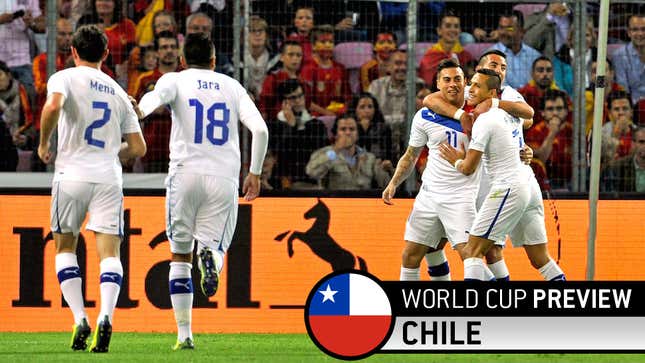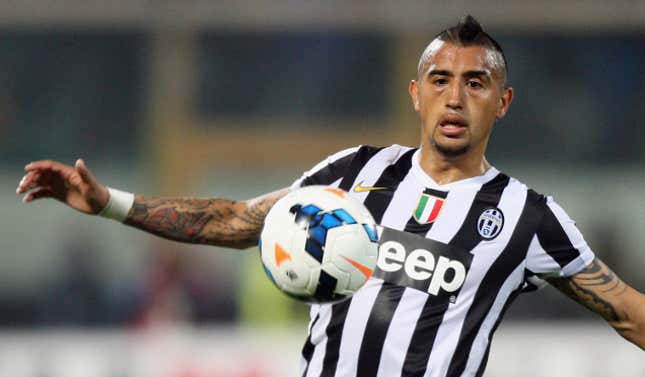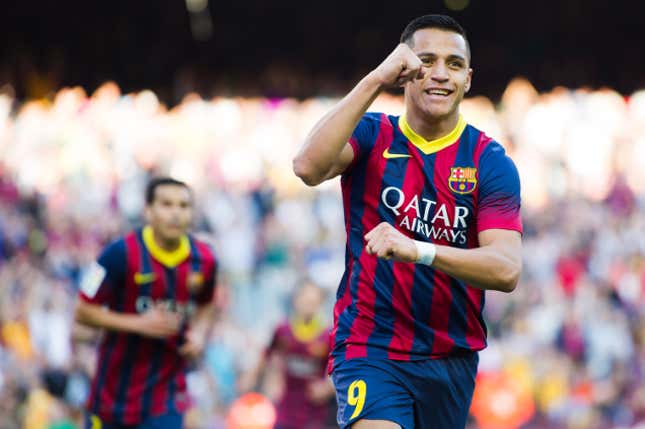
Chile's most memorable World Cup story is actually how they missed out on the 1990 and 1994 tournaments. Yes, they finished third in 1962 and gave Spain all they could handle in the first knockout round in 2010, but besides those two Cups, they've only gotten out of the group stage once, when they also fell in the round of 16. So let's stick with the interesting stuff.
In the final game of qualifying before the 1990 Cup, Chile needed a win over Brazil at the Maracanã. Late in the game, Chile losing 1-0, a Brazilian fan threw a flare on the pitch. Mere feet from the flare was Chilean goalkeeper Roberto Rojas writhing on the grass in pain, clutching his face. When Rojas lowered his hands, blood was streaming down his face. Rojas was carried off of the pitch by his incensed teammates, his shirt stained in blood. The match was suspended when the Chilean players refused to resume play in such dangerous conditions.
The first hilarious bit from this incident was Chilean striker Patricio Yáñez's reaction, which you see above. That single nut grab was directed at the general vicinity of where the flare originated, and quickly gained pop culture meme status as "the Pato Yáñez." In an interview years after the match, Yáñez described (per Google's translation) his legacy thusly: "I am ashamed when I hear kids say they did 'a Pato Yáñez' someone." Don't be ashamed, Pato, it's hilarious!
But back to the pitch. Turns out, the flare was thrown by the fetching young Brazilian lass Rosinery Mello. She was briefly detained by police while they determined if charges were necessary, but was soon released. The event made Mello famous. She gave all kinds of interviews to the Brazilian press and even made the cover of Playboy as the "Fogueteira do Maracanã."
For soccer purposes, the most important side of the story was Rojas's. After the match was suspended, officials reviewed the tape to see exactly what happened when Mello threw that flare. The television footage showed that the flare never hit Rojas at all, and the cut he sported was administered by his own hand. Rojas all along had planned on nicking himself should the result not go Chile's way, hoping the match would get canceled and Brazil would be forced to forfeit.
Instead, Rojas, Chile's manager, and the Chilean doctor (who must have been in on the scheme) were banned for life by FIFA, and Chile were disqualified from the upcoming World Cup and the subsequent one in '94. Too bad they don't make soccer scandals like they used to.
Chile's modern journey to Brazil was more mundane if more impressive. Despite getting rid of one manager midway through qualification because of poor results, Chile was never really at risk of failing to make the finals. While South American qualifying is normally a dogfight, Brazil's automatic bid for hosting the competition meant the favorites would really need to fuck up in order to miss out. Sampaoli's national team record of 5-1-1 was good enough for a nice and easy third-place CONMEBOL finish.
Roster
Goalkeepers: Claudio Bravo (Real Sociedad), Johnny Herrera (Universidad de Chile), Cristopher Toselli (Universidad Católica),
Defenders: Gonzalo Jara (Nottingham Forest), Gary Medel (Cardiff City), Mauricio Isla (Juventus), Marcos González (Unión Española), Eugenio Mena (Santos), José Rojas (Universidad de Chile), Miiko Albornoz (Malmö)
Midfielders: Jean Beausejour (Wigan Athletic), Jorge Valdívia (Palmeiras), Arturo Vidal (Juventus), Carlos Carmona (Atalanta), Rodrigo Millar (Atlas), José Pedro Fuenzalida (Colo-Colo), Charles Aránguiz (Internacional), Marcelo Díaz (Basel), Felipe Gutiérrez (Twente), Francisco Silva (Osasuna)
Forwards: Alexis Sánchez (FC Barcelona), Esteban Paredes (Colo-Colo), Eduardo Vargas (Valencia), Mauricio Pinilla (Cagliari), Fabián Orellana (Celta Vigo)
Nickname
La Roja (The Red)
FIFA World Ranking
14*
Manager
Jorge Sampaoli
In Sampaoli, Chile may have finally uncovered the rightful heir to the Marcelo Bielsa throne. Bielsa, who lead the Chilean national team from 2007-11 and brought them back to the World Cup after a two-tournament absence, was and is a soccer god in the country. Almost as important as the results to his legacy is his patented style of play. Constant pressing, fluid player interchange, and tactical flexibility are the hallmarks of a Bielsa team and became the expectation for Chile.
When politics within the Chilean Soccer Federation led to Bielsa's resignation, the country had trouble finding the right man to succeed the icon. Their first attempt was in hiring fellow Argentinian Claudio Borghi. He didn't even last two years as manager and was fired as Chile struggled mightily in qualification.
The solution came in Sampaoli, yet another Argentinian and a noted Bielsa disciple. He never coached under El Loco, but like many Chilean managers awed by his tactics, he was an early convert to the system. Chile lost their first match in World Cup qualifying under new leadership, but then won five of their next six.
Players to Watch
Arturo Vidal, Midfielder

This guy makes it all happen. Vidal is a tank. The Juventus central midfielder is one of the best box-to-box players in the world, up there with Yaya Touré in omnipresence when on the pitch. Whereas Yaya makes popping up deep in both penalty areas at any given moment look effortless, almost like he teleports from place to place, you can see the exhaust fumes billowing from Vidal when his motor is revving. He'll steam backwards into a tackle, collect the ball and slap out a pass to start the counter, then speed ahead to join the attack all in mere seconds. That is the kind of energy you need to succeed in the high-pressing, direct-attacking style Chile have implemented.
Alexis Sánchez, Striker

At Barcelona, Alexis has enjoyed easily his best season, finally capitalizing on his combination of speed, dribbling elusiveness, finishing, and work rate with a consistency befitting of a starting Barcelona forward. His 19 goals were good for fourth most in La Liga, only behind Cristiano Ronaldo, Lionel Messi, and Diego Costa.
Chilean fans must be even more excited to have the striker back on his bullshit. Though he's at best the third attacker for his club, he's the main man going forward for Chile. Playing in a more central role, Alexis in Chilean colors can roam the entire pitch, hunting for an open channel to sneak in behind the defense. He's free to be the most creative passer and the primary scorer, exactly as it should be.
Tactics
Like all teams that try to play some version of Bielsa-ball, Chile's primary tactical strategy is constant pressure. It's not a defensive-minded setup, it's more to start an early counter and transition immediately from attack to defense and back again.
Chile's commitment to pressing is more important than the particular formation they line up in. Sampaoli likes to use a 3-4-1-2, but it's not uncommon for them to start with a more traditional back four. Not that it matters too much; the full/wing backs will push high up the field to help on offense and break up counter attacks before they get too dangerous, a third central defender/midfielder will sit a little bit ahead of the deepest defenders to provide a passing outlet or charge down an attacker, and the front three will pop up all over the attacking third to find space between the lines and in behind the opposing defense. It's a well-choreographed dance, with all the fluidity of movement needing to be performed in concert with the other players in order to be effective.
Playing with three in defense can sometimes be difficult, but luckily for Chile their wing backs—the most demanding positions in a team playing a back three—Mauricio Isla and Jean Beausejour play in that same role on the club level (at Juventus and Wigan, respectively). Isla's Juve teammate and Chile's star man Arturo Vidal is also well versed in the nuances of a three central defender formation, and Alexis Sánchez is asked to press opponents in much the same way for his club as for the national team. With all of those pivotal players playing such similar roles for club and country, Chile's manager can implement his tactical vision without much of a learning curve.
Group B Fixtures
All times Eastern
June 13, 6 p.m: Chile vs. Australia at Arena Pantanal
June 18, 3 p.m.: Spain vs. Chile at Estádio do Maracanã
June 23, noon: Netherlands vs. Chile at Arena Corinthians
Complete Group B Previews
Spain | The Netherlands | Australia |Full Archive
*More proof of how dumb the rankings are; Chile are a million times better than the 13th-ranked United States
Screamer is Deadspin's soccer site. We're @ScreamerDS on Twitter. We'll be partnering with our friends at Howler Magazine throughout the World Cup. Follow them on Twitter,@whatahowler.
Top image by Jim Cooke; photos via Getty.